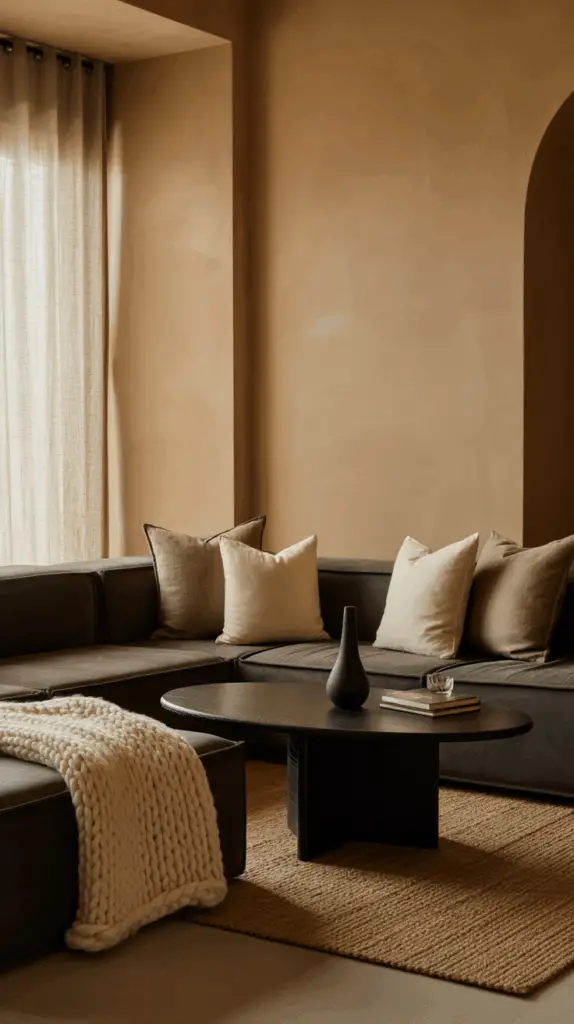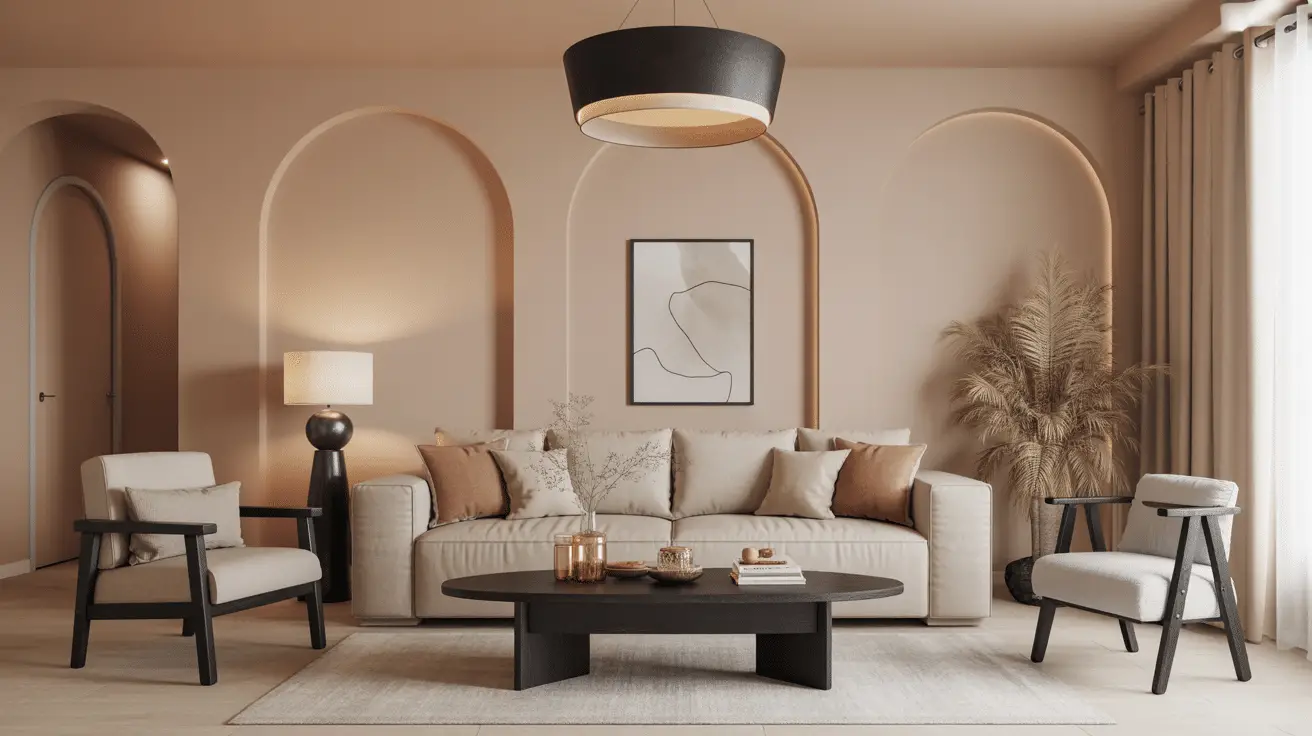How to Create a Balanced Beige and Black Living Room Atmosphere with Timeless Style
Table of Contents
Introduction
Beige and black—a pairing that might seem simple at first glance, yet it’s one of the most timeless and striking combinations in interior design. According to recent home décor trend reports, neutral color palettes continue to dominate modern living spaces, with nearly 65% of homeowners favoring earthy, monochrome tones for their calming effect. But achieving the right balance between warm beige and bold black requires thoughtful design choices.
Why? Because the harmony between light and dark defines the entire mood of a room. Beige adds warmth, comfort, and natural softness, while black anchors the space with depth and sophistication. When these hues are balanced well, the result is a living room that feels effortlessly chic—inviting yet refined, modern yet timeless.
This guide will show you how to master the beige and black aesthetic. You’ll learn how to select the right shades, integrate textures and materials, arrange lighting, and style décor that enhances both comfort and contrast. By the end, you’ll know exactly how to craft a living room atmosphere that feels grounded, luxurious, and uniquely yours.
Understanding the Power of Beige and Black
At their core, beige and black represent harmony between warmth and depth. Beige brings natural softness, reminiscent of sand, stone, and sunlight—while black introduces a grounding force that adds definition and elegance.
When designing with these tones, it’s not just about color—it’s about balance. Too much beige can make a room feel washed out, while too much black can feel heavy or cold. The ideal space lies somewhere in between, where each tone complements the other through thoughtful distribution.
Use beige as your foundation—it’s versatile, timeless, and welcoming. Black then steps in as an accent or structural detail, giving your space dimension and sophistication. Together, they create a mood that’s calm yet contemporary.
| Element | Beige Effect | Black Effect | Combined Result |
| Wall Color | Lightens and warms | Defines and contrasts | Balanced brightness |
| Furniture | Inviting and cozy | Sleek and modern | Depth and focus |
| Accessories | Softens the look | Adds drama | Harmonious texture |
| Lighting | Reflects glow | Highlights shape | Mood balance |
Choosing the Right Shades and Finishes
Not all beige or black tones are created equal. The success of this color combination depends on choosing hues that complement each other rather than compete.
For beige, consider undertones—warm beige with hints of caramel or taupe feels earthy and natural, while cool beige with gray undertones creates a more modern, sleek environment. Black, too, comes in variations: true jet black, matte charcoal, or deep graphite.
A matte or satin finish works best for both colors. High gloss can appear harsh and diminish the calm, modern vibe. Using multiple shades of beige—from creamy ivory to light mocha—adds depth without introducing new colors. Pairing that with matte black metal fixtures or a deep charcoal rug grounds the aesthetic.
You can also mix finishes for visual texture: soft linen, brushed metal, rough stone, and smooth ceramics. These subtle contrasts keep the monochrome palette from feeling flat.
| Tone | Undertone | Best Use | Mood Created |
| Warm Beige | Yellow or caramel | Walls, textiles | Cozy and organic |
| Cool Beige | Gray undertone | Rugs, curtains | Minimal and airy |
| Jet Black | Pure black | Accents, decor | Bold and dramatic |
| Charcoal | Soft gray-black | Furniture, walls | Modern and balanced |

Balancing Light and Shadow Through Layout
In a beige and black living room, lighting becomes your most powerful design tool. These two tones interact with light differently—beige reflects, while black absorbs. The goal is to use lighting and furniture placement to enhance this natural interplay.
Start by identifying your room’s natural light source. In bright spaces, black can be used more liberally on walls, furniture, or statement pieces without overwhelming the room. In darker spaces, keep beige dominant and use black as accents.
Layered lighting ensures the space feels inviting at all times of day. Combine ambient (ceiling fixtures), task (floor or table lamps), and accent lighting (spotlights, candles, or LED strips). Warm white bulbs—around 2700K—complement beige tones beautifully and keep black from appearing too stark.
Furniture layout also affects light balance. Arrange seating near natural light sources to reflect warmth, and position darker pieces strategically to anchor the space visually.
| Lighting Type | Placement | Design Effect |
| Ambient | Ceiling, recessed lights | General illumination |
| Task | Reading corners, beside sofa | Practical and cozy |
| Accent | Behind furniture or art | Adds drama and depth |
| Natural | Windows, open drapery | Highlights warm tones |
Incorporating Texture and Material Contrast
Texture is what transforms a beige and black color scheme from simple to spectacular. Since the palette is neutral, materials must provide the depth and visual intrigue.
Start by layering natural textures: a linen sofa, jute rug, or rattan accents paired with sleek black metal frames or polished wood surfaces. Textural contrast—smooth against rough, matte against soft—keeps the space engaging.
Beige offers warmth through tactile materials like wool, linen, or raw wood. Black, on the other hand, looks best when expressed in harder, more structured forms like iron, marble, or lacquer. Together, they create the perfect balance between comfort and sophistication.
If you’re worried about a room feeling too monochrome, introduce subtle accents like warm metallics (brushed brass, bronze) or deep organic greens in plants. These small touches add life while maintaining the neutral harmony.
| Texture Type | Material | Design Use | Visual Impact |
| Soft | Linen, wool, cotton | Upholstery, drapes | Warmth and comfort |
| Natural | Wood, jute, rattan | Furniture, flooring | Organic depth |
| Hard | Metal, marble | Frames, tables | Sleek structure |
| Reflective | Glass, ceramics | Accessories | Light and dimension |
Selecting Furniture That Defines the Space
Furniture is where balance becomes tangible. Each piece should contribute to the room’s harmony, creating both contrast and cohesion.
Start with beige as your base for large pieces—sofas, sectionals, and rugs. This keeps the space feeling light and spacious. Then introduce black through smaller furniture like coffee tables, sideboards, or accent chairs. The interplay creates a rhythm that feels deliberate and balanced.
Mix modern silhouettes with organic materials. For instance, a low-profile beige sofa paired with a black metal coffee table and a wooden console creates perfect equilibrium. Add soft furnishings like textured throws or cushions to bridge the contrast between colors.
When choosing finishes, remember that simplicity speaks volumes in a minimalist palette. Avoid ornate details—clean lines, rounded edges, and matte surfaces keep the aesthetic calm yet elegant.
| Furniture Piece | Dominant Color | Material | Function |
| Sofa | Beige | Linen or cotton | Foundation tone |
| Coffee Table | Black | Metal or stone | Focal contrast |
| Rug | Neutral mix | Wool or jute | Grounding warmth |
| Shelving | Black frame | Wood or matte metal | Structured depth |
Styling with Accessories and Décor
Accessories are what make your beige and black living room feel finished and personal. In minimalist color schemes, every item should feel intentional.
Start with wall art—black-and-white photography, abstract line drawings, or minimalist prints in muted tones complement this palette perfectly. Large-scale artwork framed in black adds a modern statement against beige walls.
Textiles are another way to layer personality. Cushions in mixed fabrics—velvet, linen, boucle—bring depth without clutter. Keep patterns minimal; focus on texture and subtle contrast.
Greenery is essential for breathing life into a neutral palette. A single potted olive tree or snake plant adds a hint of organic color. Metallic accents in bronze or soft gold can also introduce understated glamour without overpowering the harmony.
| Décor Type | Material | Effect |
| Wall Art | Canvas, print, or metal frame | Visual focal point |
| Soft Furnishings | Linen, boucle, velvet | Comfort and texture |
| Greenery | Live plants | Fresh contrast |
| Accent Pieces | Brass, glass | Subtle elegance |
Maintaining Harmony Through Minimalism
A beige and black living room thrives on restraint. Minimalism doesn’t mean emptiness—it means intention. Each color, texture, and accessory should serve a purpose.
To maintain visual balance, ensure that every dark element is countered by light. For example, if you have a black accent wall, place a beige sofa in front of it. If your rug is dark, choose lighter curtains or cushions to balance it out.
Clutter quickly breaks the serenity of a minimalist palette. Focus on a few high-quality pieces that define your space. This not only enhances aesthetic harmony but also promotes a sense of calm and mindfulness—key to a balanced living environment.
| Design Principle | Application | Result |
| Contrast | Light furniture + dark accents | Visual balance |
| Simplicity | Fewer, purposeful pieces | Calm composition |
| Consistency | Matching tones and finishes | Seamless flow |
| Space | Negative space use | Airy and open feel |
Conclusion
A beige and black living room embodies the perfect intersection of calm and confidence. Beige brings serenity, softness, and warmth, while black adds structure, depth, and sophistication. When these tones are balanced thoughtfully through texture, lighting, and material contrast, the result is a timeless atmosphere that feels both modern and inviting.
This palette’s beauty lies in its versatility—it adapts to minimalist apartments, urban lofts, or cozy family homes alike. By curating each element with purpose and restraint, you’ll create a space that’s more than just beautiful—it’s harmonious, grounded, and endlessly livable.

